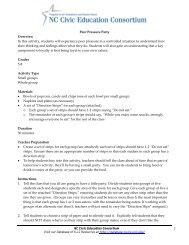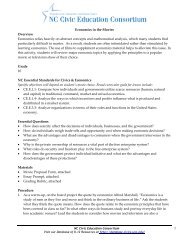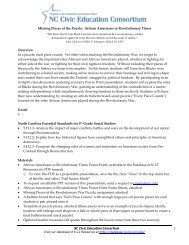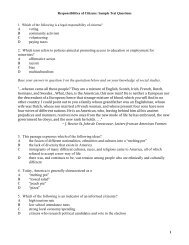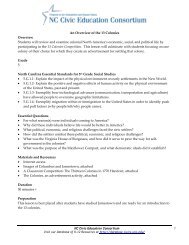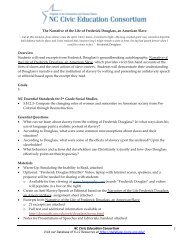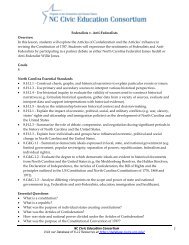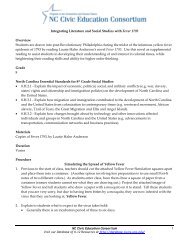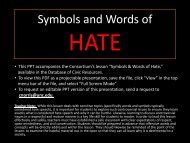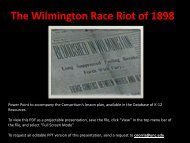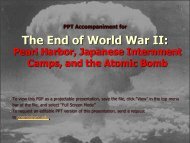American Abolitionists - Database of K-12 Resources
American Abolitionists - Database of K-12 Resources
American Abolitionists - Database of K-12 Resources
You also want an ePaper? Increase the reach of your titles
YUMPU automatically turns print PDFs into web optimized ePapers that Google loves.
<strong>American</strong> <strong>Abolitionists</strong><br />
ʺLet every slave throughout the land do this (revolt) and the days <strong>of</strong> slavery are numbered. You cannot be more oppressed<br />
than you have been ‐‐ you cannot suffer greater cruelties than you have already.” ~Henry Highland Garnet<br />
Overview<br />
Through decades <strong>of</strong> strife, and <strong>of</strong>ten at the risk <strong>of</strong> their lives, brave people joined forces as anti‐slavery<br />
activists and fought for justice despite powerful opposition. In this lesson, students will explore the<br />
<strong>American</strong> abolitionist movement through reading, discussion, and analyzing various primary source<br />
documents. Students will also participate in a group project in which they research one abolitionist in<br />
depth and create a “Digital Picture Frame” based on their assigned abolitionist’s life and<br />
accomplishments.<br />
Grade<br />
8<br />
North Carolina Essential Standards<br />
• 8.H.1.1 ‐ Construct charts, graphs, and historical narratives to explain particular events or issues.<br />
• 8.H.1.2 ‐ Summarize the literal meaning <strong>of</strong> historical documents in order to establish context.<br />
• 8.H.1.3 ‐ Use primary and secondary sources to interpret various historical perspectives.<br />
• 8.H.1.4 ‐ Use historical inquiry to evaluate the validity <strong>of</strong> sources used to construct historical<br />
narratives (e.g. formulate historical questions, gather data from a variety <strong>of</strong> sources, evaluate and<br />
interpret data and support interpretations with historical evidence).<br />
• 8.H.1.5 ‐ Analyze the relationship between historical context and decision‐making.<br />
• 8.H.2.1 ‐ Explain the impact <strong>of</strong> economic, political, social, and military conflicts (e.g. war, slavery,<br />
states’ rights and citizenship and immigration policies) on the development <strong>of</strong> North Carolina and<br />
the United States.<br />
• 8.C.1.3 ‐ Summarize the contributions <strong>of</strong> particular groups to the development <strong>of</strong> North Carolina<br />
and the United States (e.g. women, religious groups, and ethnic minorities such as <strong>American</strong><br />
Indians, African <strong>American</strong>s, and European immigrants).<br />
• 8.C&G.1.4 ‐ Analyze access to democratic rights and freedoms among various groups in North<br />
Carolina and the United States (e.g. enslaved people, women, wage earners, landless farmers,<br />
<strong>American</strong> Indians, African <strong>American</strong>s and other ethnic groups).<br />
Essential Questions<br />
• What was the mission <strong>of</strong> the abolitionist movement<br />
• What were the various tactics the abolitionists used to fight for freedom and equality<br />
• What were abolitionists risking by speaking out and fighting for emancipation <strong>of</strong> slaves<br />
• If you feel something occurring in society is unjust, what are the various ways you can make your<br />
opposition known or strive for change<br />
NC Civic Education Consortium 1<br />
Visit our <strong>Database</strong> <strong>of</strong> K-<strong>12</strong> <strong>Resources</strong> at http://database.civics.unc.edu/
Materials<br />
• <strong>American</strong> <strong>Abolitionists</strong> Power Point accompaniment, available in the <strong>Database</strong> <strong>of</strong> Civic <strong>Resources</strong><br />
(in PDF format)<br />
o To view this PDF as a projectable presentation, save the file, click “View” in the top menu bar<br />
<strong>of</strong> the file, and select “Full Screen Mode”<br />
o To request an editable PPT version <strong>of</strong> this presentation, send a request to cnorris@unc.edu<br />
• Runaway Slave Ads for “Emily” and “Tom,” attached and also available on slides 2 & 3 <strong>of</strong> the PPT<br />
• The <strong>American</strong> Abolitionist Movement, reading and questions attached<br />
• “Create a Digital Picture Frame Representing an Abolitionist,” assignment sheet attached<br />
• <strong>Abolitionists</strong> (21 attached)<br />
• Research materials (i.e. internet access, library access, encyclopedias, etc.)<br />
• Digital Picture Frame Reflection Sheet, attached<br />
Duration<br />
• 45 minutes for initial lesson and project description<br />
• Additional class time (teacher’s discretion) will need to be provided for working on the Digital<br />
Picture Frame Project, as well as for presenting the completed projects<br />
Preparation<br />
• Prior to facilitating this lesson, assign the attached “The <strong>American</strong> Abolitionist Movement”<br />
reading and questions for homework.<br />
• Teachers should determine how much class time and homework time will be allotted for<br />
completion <strong>of</strong> the Digital Picture Frame Project (at least a partial period for research and<br />
brainstorming, a partial period for writing, and a partial period for rehearsal is recommended).<br />
Procedure<br />
Warm‐Up: Exploring the Fugitive Slave Act thorough Primary Source Documents<br />
1. As a brief 5‐minute warm up, partner students up and provide half <strong>of</strong> the classroom’s partners<br />
with the “Primary Source Documents – EMILY” and the other half <strong>of</strong> partners with “Primary<br />
Source Documents – TOM.” These can be printed from slides 3 & 4 <strong>of</strong> the accompanying PPT, or<br />
they are also attached at the end <strong>of</strong> this lesson. Project slide 2 <strong>of</strong> the accompanying PPT an<br />
instruct students to review the primary source document provided to them and together discuss:<br />
• What do you first notice about the document provided to you What strikes you<br />
• What is the purpose <strong>of</strong> this document<br />
• Who do you think created this document What evidence makes you think this<br />
• What can we learn about the institution <strong>of</strong> slavery and the lives <strong>of</strong> enslaved people from this<br />
document<br />
• Specifically, what does this advertisement tell us about Emily or Tom What inferences can<br />
you make regarding this person’s life, personality, ambitions, skills, etc.<br />
2. Once students have discussed their document, ask volunteers from the pairs that examined the<br />
advertisement for Emily to report their thoughts to class. Project each advertisement (see slides 3<br />
& 4 <strong>of</strong> the accompanying PPT) so that the entire class can examine it while it is being talked about.<br />
Afterwards, follow the same process for the advertisement for Tom. After both ads have been<br />
reviewed, further discuss:<br />
• What traits or characteristics would have been required <strong>of</strong> a slave to escape<br />
NC Civic Education Consortium 2<br />
Visit our <strong>Database</strong> <strong>of</strong> K-<strong>12</strong> <strong>Resources</strong> at http://database.civics.unc.edu/
• What traits or characteristics would have been required <strong>of</strong> a free person to help an enslaved<br />
person to freedom<br />
3. Next, project slide 5, which contains an image <strong>of</strong> a poster issuing caution to runaway slaves. Ask<br />
students to examine the image and share with the class:<br />
• What do you see What first strikes you<br />
• What information is being shared Who is the intended audience<br />
• What is the purpose <strong>of</strong> this document<br />
• Who do you think created this document<br />
• What do you think prompted the creation <strong>of</strong> this document<br />
4. Project slide 6 and review the Fugitive Slave Act/Law with students, reminding them that the<br />
number <strong>of</strong> successful runaway slaves prompted Congress to pass the infamous Act in 1850 in an<br />
attempt to recapture slaves who escaped to the North, as well as to deter slaves considering<br />
running away. As a result, both enslaved and free blacks were arrested, since the only pro<strong>of</strong><br />
needed for capture was the slave ownersʹ sworn testimony. Additionally, blacks could not defend<br />
themselves in a court <strong>of</strong> law to prove their freedom. Thus, unscrupulous marshals kidnapped<br />
blacks solely for the reward money, even if they owned documents attesting their freedom. After<br />
the Fugitive Slave Lawʹs passage, the safety <strong>of</strong> free blacks became even more tenuous.<br />
Advertisements such as this one were created by abolitionists to warn people <strong>of</strong> the pending<br />
danger. Discuss:<br />
• What do you already know about abolitionists<br />
• Running away was one <strong>of</strong> the many ways enslaved people would try to resist the cruel<br />
institution they were forced into. What are some other ways people resisted their<br />
enslavement<br />
Resistance to Slavery and the <strong>American</strong> Abolitionist Movement<br />
5. Project slide 7 and explain to students that to the best <strong>of</strong> their ability, given each <strong>of</strong> their<br />
individual circumstances, those enslaved resisted the unjust situation they were in. Efforts <strong>of</strong><br />
resistance were varied among slaves‐‐covert methods <strong>of</strong> sabotaging or breaking machines and<br />
collectively working at a slower pace were employed. As evidenced in the advertisements<br />
examined at the start <strong>of</strong> the lesson, slaves would also attempt to escape. Sometimes, even more<br />
dangerous overt resistance was demonstrated, such as open defiance to a master or even slave<br />
revolts and rebellions. It is estimated that over two hundred separate slave revolts and<br />
conspiracies took place from the 1600ʹs to the end <strong>of</strong> the U.S. Civil War in 1865, although it is<br />
impossible to know just how many passive or ʺinvisibleʺ acts <strong>of</strong> resistance took place among the<br />
slaves. At its most basic level, the very act <strong>of</strong> resistance aimed to restore a sense <strong>of</strong> dignity lost to<br />
slaves by the institutionʹs tyranny. (See the Consortium’s lesson “Colonial Slave Resistance” to<br />
explore the subject <strong>of</strong> slave resistance in detail.)<br />
Not only did those enslaved fight for their own freedom, many freed Blacks, escaped slaves, and<br />
members <strong>of</strong> the white community (North and South) advocated in various ways for the end <strong>of</strong><br />
slavery and assisted slaves in escaping. These abolitionists used a variety <strong>of</strong> strategies and tactics<br />
to fight for social justice during the 1800s.<br />
NC Civic Education Consortium 3<br />
Visit our <strong>Database</strong> <strong>of</strong> K-<strong>12</strong> <strong>Resources</strong> at http://database.civics.unc.edu/
6. Project slide 8, which contains a poster advertising an “Anti‐Slavery Meeting” and continue<br />
discussing:<br />
• What is the purpose <strong>of</strong> this document and who do you think created it<br />
• What do you think prompted the creation <strong>of</strong> this document<br />
• How might the following people respond to this advertisement when coming across it<br />
(teachers can alternatively provide strips <strong>of</strong> paper to student volunteers with these choices<br />
written upon them; students can then respond when called upon by assuming the<br />
character/voice <strong>of</strong> the role assigned to them):<br />
o A freed Black<br />
o A slave owner<br />
o A housewife and mother <strong>of</strong> three<br />
o An escaped slave<br />
o A member <strong>of</strong> the Democratic Party<br />
o A Radical Republican<br />
o A Southern plantation owner<br />
o A minister<br />
• Note that in some <strong>of</strong> these cases, there is no right or wrong answer. For example, a<br />
student could argue that a minister would want to attend the meeting, claiming surely<br />
a religious person would not support such an inhumane institution <strong>of</strong> slavery. Yet,<br />
another student might note that a minister would be outraged by the meeting, since<br />
many people used religion as a way to defend slavery.<br />
• What do you think will be discussed at this meeting What types <strong>of</strong> decisions might be made<br />
7. Next, project slide 9 and review student answers to the questions posed at the end <strong>of</strong> their<br />
homework reading, “The <strong>American</strong> Abolitionist Movement,” discussing the following further:<br />
• Who were some leading abolitionists, either who were mentioned in the article or who you’ve<br />
learned about before What strategies did they use to resist slavery What facilitated and<br />
constrained their actions<br />
• It has been said that the pen is mightier than the sword. Do you think it was more effective for<br />
abolitionists to participate in armed rebellions, or to advocate through non‐violent means,<br />
such as through anti‐slavery writings Explain.<br />
• What was the constitutional and legal context that framed and legalized slavery<br />
o Review the various clauses in the Constitution that legalized slavery, as well as additional<br />
legal measures, such as<br />
• Article I, Section. 2 ‐ Slaves count as 3/5 persons<br />
• Article I, Section. 9, clause 1 ‐ No power to ban slavery until 1808<br />
• Article IV, Section, 2 ‐ Free states cannot protect slaves<br />
• Article V ‐ No Constitutional Amendment to Ban Slavery Until 1808<br />
• Gag rule instituted in 1836, tabling all petitions to end slavery<br />
• Fugitive Slave Act <strong>of</strong> 1850 – slaves were to be returned to masters<br />
• The Supreme Court, in its infamous decision in Dred Scott v Sandford (1857), ruled<br />
that Congress lacked the power to prohibit slavery in its territories and that slaves<br />
had no rights in the courts.<br />
• In many ways, abolitionists were <strong>of</strong>ten breaking the law by assisting runaways and/or<br />
advocating for emancipation. What risks were people taking by involving themselves in the<br />
abolitionist movement<br />
NC Civic Education Consortium 4<br />
Visit our <strong>Database</strong> <strong>of</strong> K-<strong>12</strong> <strong>Resources</strong> at http://database.civics.unc.edu/
8. Project slide 10 containing the “Outrage at <strong>Abolitionists</strong>” poster and ask a student volunteer to<br />
read the text to the class. Discuss:<br />
• What do you first notice about this poster<br />
• What is the tone/mood <strong>of</strong> the text<br />
• Why do you think this tone was used What is the goal <strong>of</strong> the poster<br />
• Do any words stand out to you that don’t necessarily match the tone/mood you identified<br />
(Interestingly, the poster specifically notes that “peaceable means” will be employed.)<br />
• What do you think will be discussed at this meeting What might occur after the meeting<br />
• Who might attend such a meeting and why<br />
9. Explain to students that as noted in the article they read and as evidenced by this primary source,<br />
abolitionists were <strong>of</strong>ten targeted and harassed, sometimes violently. Slavery was an incredibly<br />
controversial issue and abolitionists were not only risking being fined or arrested, they were also<br />
risking their own safety. For example, on May 17, 1838, an abolitionist convention was held in<br />
Philadelphia’s Pennsylvania Hall. A large mob burned the building to the ground, protesting<br />
against abolitionism. The city was plagued at the time with anti‐black and anti‐abolitionist<br />
violence, particularly from Philadelphian workers who feared that they would have to compete<br />
for jobs with freed slaves. Pennsylvania Hall had been open only three days when it was<br />
destroyed.<br />
Discuss:<br />
• Considering that this is just one example <strong>of</strong> the risks faced by abolitionists, imagine that you<br />
are living in 1850 and that you have been approached by abolitionists to join their fight. What<br />
do you think you would do<br />
Digital Picture Frames Representing America’s Abolitionist Movement<br />
10. Project slide 11 and tell students that they will be further exploring the brave individuals who<br />
comprised the abolitionist movement by creating a “Digital Picture Frame Project.” Pass out the<br />
attached assignment sheet and point out to students that when a digital picture frame is turned<br />
on, a picture appears (just like in a regular picture frame). Thus, they will first be creating a still<br />
image using their own bodies that represents an important moment in their assigned abolitionist’s<br />
life. Digital picture frames don’t just stay on one picture however, they move and change through<br />
various images, and some even play video clips – explain to students that they will do this as well.<br />
They will come to life from their frozen image and act out a 3‐5 minute scene regarding the life<br />
and accomplishments <strong>of</strong> their assigned abolitionist.<br />
11. Go through the assignment step by step with students to ensure understanding. Teachers should<br />
use their discretion regarding whether to allow students to choose their own group. Also,<br />
teachers should determine how much class and homework time they can devote to the project,<br />
and let students know up front so that they can plan accordingly. (At least a partial period for<br />
research and brainstorming, a partial period for writing, and a partial period for rehearsal is<br />
recommended. In addition, class time will need to be provided for presentations <strong>of</strong> final projects.)<br />
Teachers who can devote additional time may want to have a preliminary first draft due date, as<br />
well as a date for bringing in props, costumes, set pieces, etc.<br />
NC Civic Education Consortium 5<br />
Visit our <strong>Database</strong> <strong>of</strong> K-<strong>12</strong> <strong>Resources</strong> at http://database.civics.unc.edu/
<strong>12</strong>. When explaining the project to students, encourage them to think outside the box and give them<br />
examples <strong>of</strong> the various ways they can be creative. (For example, the scene students’ create might<br />
involve their assigned abolitionist meeting another famous abolitionist, assuming their research<br />
notes that such would have been possible. Or, perhaps their scene is performed as a musical. The<br />
possibilities are endless.)<br />
13. Let students know when the due date is, explaining that they should be prepared to present their<br />
project in front <strong>of</strong> the class that day. Students will begin by assuming their frozen image in front<br />
<strong>of</strong> the class, holding it for a minute or so in order for the class to observe it. (Teachers can<br />
determine whether to allow audience members to even come up and closely observe the frozen<br />
image.) They will then launch into their scene.<br />
14. There are 21 short bios <strong>of</strong> abolitionists attached, which can be distributed among the groups. As<br />
the names attached are not exhaustive <strong>of</strong> the abolitionists involved in the movement, teachers<br />
should feel free to assign alternate people.<br />
15. On the due date <strong>of</strong> the project, provide the attached presentation reflection sheet. Students should<br />
fill this in as they observe each presentation. Before presentations begin, go over the expectations<br />
for respectful audience members. Also, let students know that after each presentation, the class<br />
will participate in a feedback session in which they share what they liked about and learned from<br />
what they viewed.<br />
16. After all students have presented, culminate with a discussion:<br />
• Of the abolitionists portrayed in the Digital Picture Frames, who do you most admire and<br />
why Or, who do you think made the wisest choice in how to resist slavery and why What<br />
do you think determines what strategies various abolitionists employed<br />
• Given the constraints <strong>of</strong> the day, whose abolitionist choices were most effective and why Or,<br />
who do you think made the biggest impact and why<br />
Additional Activities<br />
• This project makes an excellent presentation for an Open House or Community night.<br />
NC Civic Education Consortium 6<br />
Visit our <strong>Database</strong> <strong>of</strong> K-<strong>12</strong> <strong>Resources</strong> at http://database.civics.unc.edu/
Primary Source Document ‐ EMILY<br />
NC Civic Education Consortium 7<br />
Visit our <strong>Database</strong> <strong>of</strong> K-<strong>12</strong> <strong>Resources</strong> at http://database.civics.unc.edu/
Primary Source Document ‐ TOM<br />
NC Civic Education Consortium 8<br />
Visit our <strong>Database</strong> <strong>of</strong> K-<strong>12</strong> <strong>Resources</strong> at http://database.civics.unc.edu/
The <strong>American</strong> Abolitionist Movement<br />
An abolitionist was a person who wanted to do away with slavery and/or contributed to the cause <strong>of</strong><br />
freeing slaves in some way (signing petitions, delivering protest speeches, harboring runaway slaves,<br />
etc.) While public opinion regarding slavery varied widely and different branches <strong>of</strong> the abolitionist<br />
movement disagreed on how to achieve their aims, abolitionists found enough strength in their<br />
common belief in individual liberty to move their agenda forward. Through decades <strong>of</strong> strife, and<br />
<strong>of</strong>ten at the risk <strong>of</strong> their lives, free Blacks, slaves, white men and women, and Native <strong>American</strong>s<br />
joined forces as anti‐slavery activists who fought for justice despite powerful opposition. Their efforts<br />
ultimately forced the issue <strong>of</strong> slavery to the forefront <strong>of</strong> national politics, fueling the split between the<br />
North and South that lead to the Civil War.<br />
<strong>Abolitionists</strong> employed all manner <strong>of</strong> strategies to persuade the <strong>American</strong> public and its leadership to<br />
end slavery. One <strong>of</strong> their first strategies was to unite groups <strong>of</strong> like‐minded individuals to fight as a<br />
group. As early as 1786, organizations had been founded to protest the practice <strong>of</strong> slavery in the<br />
United States. For instance, America’s first abolition society, the Pennsylvania Abolition Society, was<br />
founded on April 14, 1775, in Philadelphia and included members such as George Washington,<br />
Benjamin Franklin, and Thomas Paine.<br />
Although antislavery sentiment had existed during the <strong>American</strong> Revolution, the abolitionist<br />
movement did not reach crusading proportions until the 1830s. The contradictions between a national<br />
defense <strong>of</strong> slavery on <strong>American</strong> soil on the one hand, and the universal freedoms declared in the<br />
Declaration <strong>of</strong> Independence on the other hand, had created a deep moral divide in the national<br />
culture. Thus, during the thirty years leading up to the Civil War, anti‐slavery organizations spread<br />
and became increasingly effective in their methods <strong>of</strong> resistance. By 1838, more than 1,350 antislavery<br />
societies existed with almost 250,000 members, including many women.<br />
One <strong>of</strong> the most influential abolitionists <strong>of</strong> the 1830s was William Lloyd Garrison, who used the<br />
press to spread the abolitionist message. On January 1, 1831, he published the first issue <strong>of</strong> his<br />
abolitionist journal, The Liberator. In this issue, he wrote:<br />
ʺI shall strenuously contend for the immediate enfranchisement <strong>of</strong> our slave population.... On<br />
this subject I do not wish to think, or speak, or write with moderation.... I am in earnest ‐‐ I<br />
will not equivocate ‐‐ I will not excuse ‐‐ I will not retreat a single inch AND I WILL BE<br />
HEARD.ʺ<br />
Garrison was <strong>of</strong>ten attacked, verbally and physically, by anti‐abolitionist Northerners. But he also<br />
awakened other Northerners to the evil in the institution <strong>of</strong> slavery that many had decided was<br />
unchangeable. He sought to inform and remind the public <strong>of</strong> the repulsive aspects <strong>of</strong> slavery and to<br />
show how slave holders were torturers and traffickers in human life. He recognized no rights <strong>of</strong> the<br />
masters, acknowledged no compromise, and felt there should be no delay in emancipation.<br />
Garrison was joined by another powerful voice, that <strong>of</strong> Frederick Douglass, an escaped slave who<br />
inspired Northern audiences as a spokesman for the Massachusetts Anti‐Slavery Society, and later<br />
as the eloquent editor <strong>of</strong> the abolitionist weekly newspaper, Northern Star.<br />
NC Civic Education Consortium 9<br />
Visit our <strong>Database</strong> <strong>of</strong> K-<strong>12</strong> <strong>Resources</strong> at http://database.civics.unc.edu/
Garrison was also one <strong>of</strong> the principal organizers <strong>of</strong> the <strong>American</strong> Anti‐Slavery Society, founded in<br />
Philadelphia in Dec., 1833. The primary concern <strong>of</strong> the society was the denunciation <strong>of</strong> slavery as a<br />
moral evil and its members called for immediate action to free the slaves. In 1835, the society<br />
launched a massive propaganda campaign. It flooded the slave states with abolitionist literature, sent<br />
agents throughout the North to organize state and local antislavery societies, and poured petitions<br />
into Congress demanding the abolition <strong>of</strong> slavery in the District <strong>of</strong> Columbia.<br />
Another tactic <strong>of</strong> the antislavery movement involved helping slaves escape to safe refuges in the<br />
North or over the border into Canada. Known as the ʺUnderground Railroad,ʺ an elaborate network<br />
<strong>of</strong> secret routes and safe houses was firmly established in the 1830s in all parts <strong>of</strong> the North, with its<br />
most successful operation being in the old Northwest Territory. The Underground Railroad provided<br />
shelter, safety, and guidance for thousands <strong>of</strong> runaway slaves until 1865.<br />
The number <strong>of</strong> antislavery societies increased at such a rate during this period that by 1840, there<br />
were about 2,000 antislavery societies with a membership <strong>of</strong> perhaps 200,000. Yet, even with support<br />
for their cause growing, abolitionists still faced danger and violations <strong>of</strong> their rights. For example,<br />
many abolitionists spread their message through publications such as pamphlets and leaflets which<br />
contained anti‐slavery poems, slogans, essays, sermons, and songs. However, these materials were<br />
deemed so threatening in slave states that they were outlawed, ultimately a violation <strong>of</strong> the First<br />
Amendment’s promise to freedom <strong>of</strong> speech and the press.<br />
Another strategy abolitionists employed was addressing Congress, flooding representatives with<br />
petitions calling for a ban on slavery in the District <strong>of</strong> Columbia. However, in 1836 the House<br />
instituted a gag rule, which enabled legislators to table such petitions automatically, thus effectively<br />
killing them. Former President John Quincy Adams, elected to the House <strong>of</strong> Representatives in 1830,<br />
fought this so‐called gag rule as a violation <strong>of</strong> the First Amendment. The House finally repealed the<br />
gag rule in 1844.<br />
Throughout the abolitionist movement, women played an important part in working against<br />
enslavement. Black women spoke from their experience, bringing their stories to audiences to elicit<br />
empathy and action. White women came out <strong>of</strong> their domestic sphere to support the cause in various<br />
ways. For example, the National Anti‐Slavery Bazaar was a large fundraising fair run by the Boston<br />
Female Anti‐Slavery Society in 1846. Members crafted and sold abolitionist paraphernalia,<br />
household items, and publications to raise money for abolitionist activities, especially the <strong>American</strong><br />
Anti‐Slavery Society’s newspaper, the National Anti‐Slavery Standard.<br />
The abolitionist movement was further motivated to fight for freedom when on September 18 th , 1850,<br />
the US Congress passed the Fugitive Slave Act /Law, as part <strong>of</strong> the Compromise <strong>of</strong> 1850. The law<br />
declared that all runaway slaves be brought back to their masters. <strong>Abolitionists</strong> nicknamed it the<br />
ʺBloodhound Lawʺ for the dogs that were used to track down runaway slaves.<br />
As time passed, some abolitionists became more radical in their fight for freedom. Militant<br />
abolitionists felt that violence was the only way to end slavery and resorted to extreme and deadly<br />
tactics, such as inciting violent insurrections. One such example was John Brown, who led a raid on<br />
the federal armory at Harpers Ferry, Virginia (located in modern‐day West Virginia) in 1859. During<br />
NC Civic Education Consortium 10<br />
Visit our <strong>Database</strong> <strong>of</strong> K-<strong>12</strong> <strong>Resources</strong> at http://database.civics.unc.edu/
the raid, Brown seized the armory, intending to arm slaves with the weapons stolen from the arsenal.<br />
The attack failed and Brown was captured and hanged.<br />
The majority <strong>of</strong> abolitionists stood with the Union throughout the secession crisis and became militant<br />
champions <strong>of</strong> emancipation during the Civil War. Such insistent abolitionist demands for immediate<br />
freeing <strong>of</strong> the slaves, supported by radical Republicans in Congress, pushed President Lincoln in his<br />
decision to issue the Emancipation Proclamation. However, the Emancipation Proclamation was<br />
criticized at the time for freeing only the slaves over which the Union had no power. But, the<br />
Proclamation did provide the legal framework for the emancipation <strong>of</strong> nearly all four million slaves in<br />
the South as the Union armies advanced.<br />
While the Emancipation Proclamation freed Southern slaves as a war measure, abolitionists were<br />
concerned that it had not made slavery <strong>of</strong>ficially illegal in all the states. Though several former slave<br />
states had already passed legislation prohibiting slavery, in a few states, slavery continued to exist.<br />
Finally, on December 18, 1865, the Thirteenth Amendment was enacted, bringing a legal end to<br />
slavery in all states.<br />
Even with the passing <strong>of</strong> the Thirteenth Amendment however, many abolitionists, such as Wendell<br />
Philips, insisted the movement’s work was not complete. Philips and his followers believed the<br />
<strong>American</strong> Anti‐Slavery Society should continue its work until complete political equality for all black<br />
males was granted. The Society continued until 1870, working to demand land, the right to vote, and<br />
education for the freedman. Only when the Fifteenth Amendment (extending male suffrage to<br />
African‐<strong>American</strong> men) was passed did the society declare its mission completed.<br />
Through their courage, perseverance, and activism, abolitionists brought hope to those enslaved,<br />
spread anti‐slavery sentiment, and ultimately had a hand in ensuring the institution <strong>of</strong> slavery ended.<br />
The fight for equality begun by abolitionists lived on to inspire the subsequent founding <strong>of</strong> the<br />
National Association for the Advancement <strong>of</strong> Colored People in 1909 and the fight for civil rights<br />
throughout the 1900s.<br />
Sources:<br />
http://www.encyclopedia.com/topic/abolitionists.aspx<br />
http://countrystudies.us/united‐states/history‐59.htm<br />
http://rmc.library.cornell.edu/abolitionism/index.htm<br />
http://afgen.com/abmovement.html<br />
Answer the following on notebook paper:<br />
1. What was the mission <strong>of</strong> the abolitionist movement<br />
2. What were the various tactics the abolitionists used to fight for freedom and equality (List at<br />
least 4 examples.)<br />
NC Civic Education Consortium 11<br />
Visit our <strong>Database</strong> <strong>of</strong> K-<strong>12</strong> <strong>Resources</strong> at http://database.civics.unc.edu/
3. Of the tactics employed by various abolitionists, which do you think was most effective in<br />
bringing about an end to slavery and why<br />
4. What were abolitionists risking by speaking out and fighting for emancipation <strong>of</strong> slaves<br />
5. Why do you think the abolitionist movement and the women’s suffrage movement <strong>of</strong>ten joined<br />
forces<br />
6. Imagine you, as an enslaved person, have runaway and are relying on abolitionists along the<br />
Underground Railroad to assist you. What would be exciting about this situation What would<br />
be frightening<br />
7. Why do you think some abolitionists grew more militant in their fight for justice and equality<br />
8. Summarize the purpose <strong>of</strong> the Emancipation Proclamation. In your opinion, was it an effective<br />
document (for freeing the slaves or for other purposes) Why or why not<br />
9. Why did some abolitionists continue their work, even after the Thirteenth Amendment was<br />
ratified<br />
10. If you feel something occurring in society is unjust, what are the various ways you can make your<br />
opposition known or strive for change<br />
NC Civic Education Consortium <strong>12</strong><br />
Visit our <strong>Database</strong> <strong>of</strong> K-<strong>12</strong> <strong>Resources</strong> at http://database.civics.unc.edu/
Assignment:<br />
Create a Digital Picture Frame Representing an Abolitionist<br />
Digital picture frames are neat inventions. When a digital picture frame is turned on, the viewer first<br />
sees a frozen image – a picture. Then, the image in the digital picture frame switches to a new picture,<br />
showing the viewer something different; some digital picture frames even play video clips.<br />
Your group will create a digital picture frame project based on the abolitionist assigned to your<br />
group.<br />
Your project will begin with your group frozen in a 3‐D picture that represents an important moment<br />
in the life <strong>of</strong> the abolitionist assigned to you. Then, that image will switch to something different – a<br />
“video.” Your group will do this by coming to life from your frozen image and acting out a 3‐5<br />
minute scene regarding the life and accomplishments <strong>of</strong> your abolitionist.<br />
Step 1: Review the roles below and determine who in your group will be responsible for each. While<br />
one group member will be in charge <strong>of</strong> each aspect <strong>of</strong> the project, all group members must actively<br />
contribute to each step.<br />
Research Manager: Lead the group during Step 2, during which you will ensure everyone in<br />
your group engages in productive research about your abolitionist. Make sure each person<br />
consults a different source and keeps track <strong>of</strong> the sources consulted.<br />
Director: Lead the group during Step 3, in which your group will brainstorm, decide upon, and<br />
place one or more <strong>of</strong> you in a frozen image that represents an important moment from your<br />
abolitionist’s life. You will also lead the group during Step 6, ensuring everyone is participating<br />
and stays on task during the rehearsal <strong>of</strong> your scene.<br />
Script Writer: Lead the group during Step 4, during which your group will brainstorm and write<br />
down a 3‐5 minute scene that will be acted out when the digital picture frame image turns to<br />
video. While you will be responsible for writing down each actor’s lines on paper, everyone must<br />
contribute and <strong>of</strong>fer ideas as to what they think they would say. Make sure everyone is equally<br />
involved in developing the script.<br />
Artistic Designer: Lead the group during Step 5, brainstorming what materials can be brought to<br />
class or prepared to enhance your frozen image and scene. This can include costumes, props, set<br />
pieces, music, etc.<br />
Step 2: Research the abolitionist assigned to you. Learn everything you can about this person, such<br />
as:<br />
• Background, life experiences, and interesting facts<br />
• Talents, interests, and skills (i.e. writing, public speaking, etc.)<br />
• Why he/she became an abolitionist<br />
• The ways he/she worked to ensure slavery was ended (What tactics did he/she use)<br />
• Affiliations with other prominent abolitionists or abolitionist groups<br />
• Impact on the abolitionist movement<br />
NC Civic Education Consortium 13<br />
Visit our <strong>Database</strong> <strong>of</strong> K-<strong>12</strong> <strong>Resources</strong> at http://database.civics.unc.edu/
Take detailed notes and ensure you write down your sources. You will use this information to<br />
create your frozen image and scene.<br />
Step 3: Brainstorm what you think is the most important moment in this person’s life as an<br />
abolitionist, or what you feel is the most important accomplishment this person made in regards to<br />
the abolitionist movement. Design one or more <strong>of</strong> your bodies into a frozen image representing this<br />
moment.<br />
Step 4: From this frozen moment, your picture will switch to a video, at which point you will all act<br />
out a scene regarding this abolitionist. Write the script by working together. Each person must<br />
contribute ideas.<br />
Your final script:<br />
• Should be written with the purpose <strong>of</strong> educating your classmates about this abolitionist<br />
• Must contain accurate information (including at least the information from the questions<br />
answered during Frame 2)<br />
• Should be realistic and historically accurate<br />
• Should be creative<br />
• Should not contain grammatical errors<br />
• Will be turned in and must include your list <strong>of</strong> resources<br />
Step 5: Brainstorm and prepare materials to enhance your frozen image and scene. Consider how the<br />
use <strong>of</strong> props, scenery, costumes, music, etc. can make your presentation more believable and<br />
entertaining. Items can be brought from home or created in class. If you will need particular<br />
supplies, consult with your teacher.<br />
Step 6: Practice! Practice! Practice! Your final presentation should be 3‐5 minutes long when<br />
performed. Do your best to memorize your lines; if you must keep your script in hand, do not read<br />
directly from it.<br />
Your final presentation should:<br />
• Start with a frozen image that then turns to video (at which point your scene is acted out).<br />
• Be presented as a serious performance (i.e. assume the appropriate persona <strong>of</strong> your character,<br />
keep a straight face, memorize your lines and deliver them as believably as possible, support<br />
your fellow actors, etc.)<br />
• Be organized and well rehearsed; props, music, costumes etc. if present in scene should be<br />
used effectively<br />
• Be engaging and creative<br />
• Teach all <strong>of</strong> us about your abolitionist, his/her life and accomplishments, his/her tactics in<br />
combating slavery, etc.<br />
• Make sure each <strong>of</strong> you speaks at an appropriate volume and uses appropriate emotion to<br />
convey your character<br />
Due Date: _________________________________________<br />
NC Civic Education Consortium 14<br />
Visit our <strong>Database</strong> <strong>of</strong> K-<strong>12</strong> <strong>Resources</strong> at http://database.civics.unc.edu/
<strong>Abolitionists</strong><br />
‐‐‐‐‐‐‐‐‐‐‐‐‐‐‐‐‐‐‐‐‐‐‐‐‐‐‐‐‐‐‐‐‐‐‐‐‐‐‐‐‐‐‐‐‐‐‐‐‐‐‐‐‐‐‐‐‐‐‐‐‐‐‐‐‐‐‐‐‐‐‐‐‐‐‐‐‐‐‐‐‐‐‐‐‐‐‐‐‐‐‐‐‐‐‐‐‐‐‐‐‐‐‐‐‐‐‐‐‐‐‐‐‐‐‐‐‐‐‐‐‐‐‐‐<br />
Harriet Beecher Stowe<br />
Harriet Beecher Stowe (June 14, 1811 – July 1, 1896) was an abolitionist and<br />
author. Her famous novel Uncle Tom’s Cabin depicted what life was like for<br />
African‐<strong>American</strong>s under slavery. Published in 1852, the novel (which was later<br />
made into a play) is credited for helping <strong>American</strong>s become aware <strong>of</strong> the cruel<br />
reality <strong>of</strong> life for a slave and made the political issues <strong>of</strong> the 1850s regarding<br />
slavery tangible to millions. As the book spread, it energized anti‐slavery forces in the North,<br />
while provoking widespread anger in the South, where the book was banned. Upon meeting<br />
Stowe, Abraham Lincoln allegedly remarked, ʺSo youʹre the little lady who started this great<br />
war!ʺ<br />
‐‐‐‐‐‐‐‐‐‐‐‐‐‐‐‐‐‐‐‐‐‐‐‐‐‐‐‐‐‐‐‐‐‐‐‐‐‐‐‐‐‐‐‐‐‐‐‐‐‐‐‐‐‐‐‐‐‐‐‐‐‐‐‐‐‐‐‐‐‐‐‐‐‐‐‐‐‐‐‐‐‐‐‐‐‐‐‐‐‐‐‐‐‐‐‐‐‐‐‐‐‐‐‐‐‐‐‐‐‐‐‐‐‐‐‐‐‐‐‐‐‐‐‐<br />
William Lloyd Garrison<br />
William Lloyd Garrison (1805‐1879), the lightning rod <strong>of</strong> the abolitionist<br />
movement, promoted “moral suasion,” or nonviolent and non‐political<br />
resistance, to achieve emancipation. In 1831, he began publishing The Liberator,<br />
was elected to the U.S. Senate as a Whig party member in 1847, primarily because<br />
e <strong>of</strong> his anti‐slavery stance. He fought a hard political battle against the Missouri<br />
uri Compromise <strong>of</strong> 1850 and in favor <strong>of</strong> the admission <strong>of</strong> California as a free<br />
document created deep divisions in the abolitionist movement. However, his unflagging<br />
conviction and his influence in promoting “immediatism” shaped the course <strong>of</strong> abolitionism<br />
in America.<br />
‐‐‐‐‐‐‐‐‐‐‐‐‐‐‐‐‐‐‐‐‐‐‐‐‐‐‐‐‐‐‐‐‐‐‐‐‐‐‐‐‐‐‐‐‐‐‐‐‐‐‐‐‐‐‐‐‐‐‐‐‐‐‐‐‐‐‐‐‐‐‐‐‐‐‐‐‐‐‐‐‐‐‐‐‐‐‐‐‐‐‐‐‐‐‐‐‐‐‐‐‐‐‐‐‐‐‐‐‐‐‐‐‐‐‐‐‐‐‐‐‐‐‐‐<br />
Levi C<strong>of</strong>fin<br />
Levi C<strong>of</strong>fin (1798‐1867), a Quaker and successful merchant, along with his wife<br />
Catharine, helped thousands <strong>of</strong> slaves on their way North and to Canada on the<br />
Underground Railroad. Raised in a religious Southern family who never owned<br />
slaves, C<strong>of</strong>fin hated oppression. C<strong>of</strong>fin stated that the Bible did not mention race<br />
when it urged people to be charitable to one another. Because <strong>of</strong> his prominent<br />
role in helping slaves to freedom, C<strong>of</strong>fin’s home was given the title <strong>of</strong> “Grand<br />
Central Station” and he, the “President” <strong>of</strong> the Underground Railroad.<br />
‐‐‐‐‐‐‐‐‐‐‐‐‐‐‐‐‐‐‐‐‐‐‐‐‐‐‐‐‐‐‐‐‐‐‐‐‐‐‐‐‐‐‐‐‐‐‐‐‐‐‐‐‐‐‐‐‐‐‐‐‐‐‐‐‐‐‐‐‐‐‐‐‐‐‐‐‐‐‐‐‐‐‐‐‐‐‐‐‐‐‐‐‐‐‐‐‐‐‐‐‐‐‐‐‐‐‐‐‐‐‐‐‐‐‐‐‐‐‐‐‐‐‐‐<br />
NC Civic Education Consortium 15<br />
Visit our <strong>Database</strong> <strong>of</strong> K-<strong>12</strong> <strong>Resources</strong> at http://database.civics.unc.edu/
Wendell Phillips<br />
Wendell Phillips (1811‐1884) was one <strong>of</strong> the abolitionist movement’s most<br />
powerful orators. The Harvard‐educated lawyer came from a wealthy and<br />
influential Boston family, many <strong>of</strong> whom were appalled by his activism in<br />
support <strong>of</strong> the abolitionist cause. However, he was undaunted in his work and<br />
was thrust into prominence when he gave a riveting speech in Boston’s<br />
Faneuil Hall in defense <strong>of</strong> Elijah Lovejoy in 1837. The Rev. Lovejoy had been<br />
murdered for his repeated attempts to run a printing press sympathetic to the<br />
abolitionist cause. Phillips used plain, yet metaphorical language to convey his message. He<br />
also gave generously to abolitionists in need <strong>of</strong> financial assistance.<br />
‐‐‐‐‐‐‐‐‐‐‐‐‐‐‐‐‐‐‐‐‐‐‐‐‐‐‐‐‐‐‐‐‐‐‐‐‐‐‐‐‐‐‐‐‐‐‐‐‐‐‐‐‐‐‐‐‐‐‐‐‐‐‐‐‐‐‐‐‐‐‐‐‐‐‐‐‐‐‐‐‐‐‐‐‐‐‐‐‐‐‐‐‐‐‐‐‐‐‐‐‐‐‐‐‐‐‐‐‐‐‐‐‐‐‐‐‐‐‐‐‐‐‐‐<br />
Lucretia Mott<br />
Lucretia Mott (1793‐1880) was a Quaker and a “non‐resistant” pacifist who<br />
was committed to black emancipation and women’s rights. As a woman,<br />
her role in <strong>of</strong>ficial abolitionist movements was fraught with difficulties. In<br />
1840, she and six other <strong>American</strong> female delegates to the World Anti‐<br />
Slavery Convention in England were refused seats. Because <strong>of</strong> her<br />
opposition to violence <strong>of</strong> any kind, Mott did not support the Civil War as a<br />
means <strong>of</strong> liberating slaves. She did, however, welcome the War’s hastening <strong>of</strong> emancipation.<br />
Of her principles she wrote, “I have no idea, because I am a non‐resistant, <strong>of</strong> submitting<br />
tamely to injustice inflicted either on me or on the slave. I will oppose it with all the moral<br />
powers with which I am endowed. I am no advocate <strong>of</strong> passivity.”<br />
‐‐‐‐‐‐‐‐‐‐‐‐‐‐‐‐‐‐‐‐‐‐‐‐‐‐‐‐‐‐‐‐‐‐‐‐‐‐‐‐‐‐‐‐‐‐‐‐‐‐‐‐‐‐‐‐‐‐‐‐‐‐‐‐‐‐‐‐‐‐‐‐‐‐‐‐‐‐‐‐‐‐‐‐‐‐‐‐‐‐‐‐‐‐‐‐‐‐‐‐‐‐‐‐‐‐‐‐‐‐‐‐‐‐‐‐‐‐‐‐‐‐‐‐<br />
Lydia Maria Child<br />
Novelist, scholar, and activist for women’s rights, Lydia Maria Child (1802‐<br />
1880) became an abolitionist after she began reading Garrison’s news journal,<br />
The Liberator. In 1833, Child wrote “An Appeal to that Class <strong>of</strong> <strong>American</strong>s<br />
Called Africans,” an anti‐slavery tract in which she declared her willingness to<br />
battle for emancipation. Her new abolitionist rhetoric so repelled readers that<br />
Childʹs books sold poorly, and she could not find a publisher willing to accept<br />
her work. From 1841‐43, Child was the editor <strong>of</strong> the National Anti‐Slavery<br />
Standard, the <strong>American</strong> Anti‐Slavery Society’s newspaper. She later resigned because <strong>of</strong><br />
infighting among the societyʹs members, who were divided in their support for the diverging<br />
philosophies, “moral suasion” and political persuasion. Child revitalized her role as an<br />
opponent <strong>of</strong> slavery after the passage <strong>of</strong> the Fugitive Slave Law in 1850 and John Brown’s<br />
raid on Harper’s Ferry in 1859. She continued publishing letters, edited Harriet Jacob’s<br />
Incidents in the Life <strong>of</strong> a Slave Girl, and wrote primers and anti‐slavery tracts to combat racial<br />
injustice.<br />
NC Civic Education Consortium 16<br />
Visit our <strong>Database</strong> <strong>of</strong> K-<strong>12</strong> <strong>Resources</strong> at http://database.civics.unc.edu/
Samuel May<br />
Samuel May’s life was forever changed when he heard William Lloyd<br />
Garrison lecture about immediate, unconditional emancipation without<br />
expatriation in 1830. May (1797‐1871) wrote <strong>of</strong> that experience, “my soul was<br />
baptized in his spirit, and ever since I have been a disciple and fellow‐laborer<br />
<strong>of</strong> Wm. Lloyd Garrison.” May, a Unitarian minister, was a pacifist and<br />
practiced non‐violent resistance by lecturing, acting as a general agent <strong>of</strong> the<br />
Massachusetts Anti‐Slavery Society, and sheltering slaves on the<br />
Underground Railroad. In one notable case, May helped to liberate William “Jerry” Henry,<br />
who had been taken into custody in Syracuse under the Fugitive Slave Law, and was to be<br />
returned to slavery. After the “Jerry Rescue,” a pro‐slavery mob attacked May and other<br />
rescuers and burned the unwavering May in effigy.<br />
‐‐‐‐‐‐‐‐‐‐‐‐‐‐‐‐‐‐‐‐‐‐‐‐‐‐‐‐‐‐‐‐‐‐‐‐‐‐‐‐‐‐‐‐‐‐‐‐‐‐‐‐‐‐‐‐‐‐‐‐‐‐‐‐‐‐‐‐‐‐‐‐‐‐‐‐‐‐‐‐‐‐‐‐‐‐‐‐‐‐‐‐‐‐‐‐‐‐‐‐‐‐‐‐‐‐‐‐‐‐‐‐‐‐‐‐‐‐‐‐‐‐‐‐<br />
Sojourner Truth<br />
Despite her inability to read or write, Sojourner Truth (ca. 1797‐1883)<br />
had a commanding presence and considerable oratorical powers. She<br />
was one <strong>of</strong> the best known and esteemed black women <strong>of</strong> the nineteenth<br />
century. Born a New York slave and given the name Isabella Baumfree,<br />
Sojourner Truth gained her freedom when New York abolished slavery<br />
in 1827. A pacifist, she transformed herself into an activist for<br />
abolitionism and proclaimed her new identity by changing her name to<br />
Sojourner Truth. Her anti‐slavery activities included recruiting black<br />
troops, publishing her narrative, and winning a civil rights lawsuit. Her<br />
circle <strong>of</strong> influence included both black and white allies as well as several presidents.<br />
(President Abraham Lincoln chose her to be a counselor to the freedmen in Washington.)<br />
Sojourner Truth drew upon her experience as a black woman and former slave, advocating<br />
the abolition <strong>of</strong> slavery, civil liberties for African <strong>American</strong>s, and women’s rights.<br />
‐‐‐‐‐‐‐‐‐‐‐‐‐‐‐‐‐‐‐‐‐‐‐‐‐‐‐‐‐‐‐‐‐‐‐‐‐‐‐‐‐‐‐‐‐‐‐‐‐‐‐‐‐‐‐‐‐‐‐‐‐‐‐‐‐‐‐‐‐‐‐‐‐‐‐‐‐‐‐‐‐‐‐‐‐‐‐‐‐‐‐‐‐‐‐‐‐‐‐‐‐‐‐‐‐‐‐‐‐‐‐‐‐‐‐‐‐‐‐‐‐‐‐‐<br />
Lewis Tappan<br />
Lewis Tappan (1788‐1873), a wealthy merchant from a strong Calvinist<br />
family, is best known for his role in organizing the defense <strong>of</strong> Joseph<br />
Cinque in the Amistad trial. Tappan also funded anti‐slavery journals and<br />
helped to form the <strong>American</strong> Anti‐Slavery Society, which he later<br />
abandoned because <strong>of</strong> his disapproval <strong>of</strong> women’s involvement in the<br />
society. Tappan and other disaffected former members <strong>of</strong> the <strong>American</strong><br />
Anti‐Slavery Society formed the <strong>American</strong> and Foreign Anti‐Slavery<br />
Society, which employed political abolitionism. After the passage <strong>of</strong> the<br />
Fugitive Slave Law <strong>of</strong> 1850, Tappan supported the Underground Railroad, and he fought for<br />
black civil rights in the North. His abolitionist deeds were <strong>of</strong>ten met with hostility, which<br />
extended as far as the destruction <strong>of</strong> a church built by Tappan and his brother.<br />
‐‐‐‐‐‐‐‐‐‐‐‐‐‐‐‐‐‐‐‐‐‐‐‐‐‐‐‐‐‐‐‐‐‐‐‐‐‐‐‐‐‐‐‐‐‐‐‐‐‐‐‐‐‐‐‐‐‐‐‐‐‐‐‐‐‐‐‐‐‐‐‐‐‐‐‐‐‐‐‐‐‐‐‐‐‐‐‐‐‐‐‐‐‐‐‐‐‐‐‐‐‐‐‐‐‐‐‐‐‐‐‐‐‐‐‐‐‐‐‐‐‐‐‐<br />
NC Civic Education Consortium 17<br />
Visit our <strong>Database</strong> <strong>of</strong> K-<strong>12</strong> <strong>Resources</strong> at http://database.civics.unc.edu/
William Seward<br />
William Seward (1801‐1872), <strong>of</strong> Auburn, New York, served as governor <strong>of</strong><br />
New York from 1838 to 1842. He was elected to the U.S. Senate as a Whig party<br />
member in 1847, primarily because <strong>of</strong> his anti‐slavery stance. He fought a hard<br />
political battle against the Missouri Compromise <strong>of</strong> 1850 and in favor <strong>of</strong> the<br />
admission <strong>of</strong> California as a free state.<br />
Seward later s<strong>of</strong>tened his stance on slavery to appease Southerners during his<br />
unsuccessful run for president on the Republican ticket. Lincoln made Seward<br />
his Secretary <strong>of</strong> State, and called upon Seward to help compose the Emancipation<br />
Proclamation. Seward also sheltered slaves on the Underground Railroad. He admired the<br />
work <strong>of</strong> Harriet Tubman, and sold her the land in Auburn, New York, where she built her<br />
home.<br />
‐‐‐‐‐‐‐‐‐‐‐‐‐‐‐‐‐‐‐‐‐‐‐‐‐‐‐‐‐‐‐‐‐‐‐‐‐‐‐‐‐‐‐‐‐‐‐‐‐‐‐‐‐‐‐‐‐‐‐‐‐‐‐‐‐‐‐‐‐‐‐‐‐‐‐‐‐‐‐‐‐‐‐‐‐‐‐‐‐‐‐‐‐‐‐‐‐‐‐‐‐‐‐‐‐‐‐‐‐‐‐‐‐‐‐‐‐‐‐‐‐‐‐‐<br />
Frederick Douglass<br />
As a lecturer, writer, editor and ex‐slave, Frederick Douglass (ca. 1818‐<br />
1895) emerged as the most prominent African <strong>American</strong> <strong>of</strong> the nineteenth<br />
century to fight for racial justice. Under Garrison’s mentorship, Douglass<br />
adopted “moral suasion” as an abolitionist strategy. Impatient with this<br />
approach, Douglass later broke from Garrison, believing that political<br />
activism was the only way to achieve freedom. Although vehement in his<br />
rhetoric, Douglas refused to use violence. Indeed, he refused to defend or<br />
take part in John Brown’s raid at Harper’s Ferry. Douglass wrote three<br />
autobiographies, edited four newspapers, lectured nationally and internationally, and<br />
recruited black soldiers for the Civil War. He advised and pressured Lincoln to make slavery<br />
the single most important issue <strong>of</strong> the Civil War and remained committed to integration and<br />
civil rights for all <strong>American</strong>s throughout his life.<br />
‐‐‐‐‐‐‐‐‐‐‐‐‐‐‐‐‐‐‐‐‐‐‐‐‐‐‐‐‐‐‐‐‐‐‐‐‐‐‐‐‐‐‐‐‐‐‐‐‐‐‐‐‐‐‐‐‐‐‐‐‐‐‐‐‐‐‐‐‐‐‐‐‐‐‐‐‐‐‐‐‐‐‐‐‐‐‐‐‐‐‐‐‐‐‐‐‐‐‐‐‐‐‐‐‐‐‐‐‐‐‐‐‐‐‐‐‐‐‐‐‐‐‐‐<br />
Gerrit Smith<br />
Gerrit Smith (1797‐1874) was a wealthy abolitionist from Utica, New<br />
York. His conversion to abolitionism occurred in 1835, when he<br />
attended an abolitionist conference in Utica, New York. The meeting<br />
was disrupted by a violent mob <strong>of</strong> anti‐abolitionists. Consequently,<br />
Smith <strong>of</strong>fered his Peterboro, New York estate to house the conference<br />
and, there, made a powerful speech on behalf <strong>of</strong> the cause. He became<br />
the president <strong>of</strong> the New York Anti‐Slavery Society for three years.<br />
Smith served as Station Master <strong>of</strong> the Underground railroad and sold<br />
portions <strong>of</strong> his land to fugitive slaves for the nominal fee <strong>of</strong> one dollar.<br />
Gerrit Smith was also one <strong>of</strong> the Secret Six, a group <strong>of</strong> supporters who<br />
gave financial assistance to John Brown for his raid at Harper’s Ferry. Smith ran for president<br />
three times and was the only abolitionist to hold a Congressional <strong>of</strong>fice.<br />
NC Civic Education Consortium 18<br />
Visit our <strong>Database</strong> <strong>of</strong> K-<strong>12</strong> <strong>Resources</strong> at http://database.civics.unc.edu/
John Brown<br />
John Brown (May 9, 1800 – December 2, 1859) was a radical<br />
abolitionist who advocated and practiced armed insurrection as a<br />
means to end all slavery. He led the Pottawatomie Massacre in 1856<br />
in Bleeding Kansas and made his name in the unsuccessful raid at<br />
Harpers Ferry in 1859. Brown attempted to start a liberation<br />
movement among enslaved African <strong>American</strong>s in Harpers Ferry by<br />
stealing weapons from the federal arsenal located there and arming<br />
slaves. His attempt was unsuccessful and he was tried for treason<br />
against the state <strong>of</strong> Virginia, the murder <strong>of</strong> five proslavery<br />
Southerners, and inciting a slave insurrection and was subsequently hanged. The Harpers<br />
Ferry raid in 1859 escalated tensions that a year later led to secession and the <strong>American</strong> Civil<br />
War.<br />
‐‐‐‐‐‐‐‐‐‐‐‐‐‐‐‐‐‐‐‐‐‐‐‐‐‐‐‐‐‐‐‐‐‐‐‐‐‐‐‐‐‐‐‐‐‐‐‐‐‐‐‐‐‐‐‐‐‐‐‐‐‐‐‐‐‐‐‐‐‐‐‐‐‐‐‐‐‐‐‐‐‐‐‐‐‐‐‐‐‐‐‐‐‐‐‐‐‐‐‐‐‐‐‐‐‐‐‐‐‐‐‐‐‐‐‐‐‐‐‐‐‐‐‐<br />
William Still<br />
William Still (November 1819 or October 7, 1821 – July 14, 1902) was an<br />
African‐ abolitionist, conductor on the Underground Railroad, writer,<br />
historian and civil rights activist. In 1844, he moved to Philadelphia,<br />
Pennsylvania, where he began working as a clerk for the Pennsylvania Anti‐<br />
Slavery Society. When Philadelphia abolitionists organized a committee to aid<br />
runaway slaves reaching Philadelphia, Still became its chairman. By the 1850s,<br />
Still was a leader <strong>of</strong> Philadelphiaʹs African‐<strong>American</strong> community. In 1859 he<br />
attempted to desegregate the cityʹs public transit system.<br />
‐‐‐‐‐‐‐‐‐‐‐‐‐‐‐‐‐‐‐‐‐‐‐‐‐‐‐‐‐‐‐‐‐‐‐‐‐‐‐‐‐‐‐‐‐‐‐‐‐‐‐‐‐‐‐‐‐‐‐‐‐‐‐‐‐‐‐‐‐‐‐‐‐‐‐‐‐‐‐‐‐‐‐‐‐‐‐‐‐‐‐‐‐‐‐‐‐‐‐‐‐‐‐‐‐‐‐‐‐‐‐‐‐‐‐‐‐‐‐‐‐‐‐‐<br />
Harriet Jacobs<br />
Harriet Ann Jacobs (February 11, 1813 ‐ March 7, 1897) was born a slave in<br />
Edenton, North Carolina in 1813. She escaped slavery in 1835 and became a<br />
writer, abolitionist speaker and reformer. Jacobsʹ single work, Incidents in the<br />
Life <strong>of</strong> a Slave Girl, published in 1861 under the pseudonym ʺLinda Brentʺ,<br />
was one <strong>of</strong> the first autobiographical narratives about the struggle for freedom<br />
by female slaves and an account <strong>of</strong> the sexual abuse they endured.<br />
NC Civic Education Consortium 19<br />
Visit our <strong>Database</strong> <strong>of</strong> K-<strong>12</strong> <strong>Resources</strong> at http://database.civics.unc.edu/
Harriet Tubman<br />
Harriet Tubman (born Araminta Ross; c. 1822 – March 10, 1913) was an<br />
African‐<strong>American</strong> abolitionist, humanitarian, and Union spy during the Civil<br />
War. After escaping from slavery, into which she was born, she made<br />
thirteen missions to rescue over seventy slaves using the network <strong>of</strong><br />
antislavery activists and safe houses known as the Underground Railroad.<br />
She later helped John Brown recruit men for his raid on Harpers Ferry, and<br />
in the post‐war era struggled for womenʹs suffrage.<br />
‐‐‐‐‐‐‐‐‐‐‐‐‐‐‐‐‐‐‐‐‐‐‐‐‐‐‐‐‐‐‐‐‐‐‐‐‐‐‐‐‐‐‐‐‐‐‐‐‐‐‐‐‐‐‐‐‐‐‐‐‐‐‐‐‐‐‐‐‐‐‐‐‐‐‐‐‐‐‐‐‐‐‐‐‐‐‐‐‐‐‐‐‐‐‐‐‐‐‐‐‐‐‐‐‐‐‐‐‐‐‐‐‐‐‐‐‐‐‐‐‐‐‐‐<br />
Nat Turner<br />
Nathaniel ʺNatʺ Turner (October 2, 1800 – November 11, 1831) was a slave<br />
who led a slave rebellion in Virginia on August 21, 1831 that resulted in 60<br />
deaths, the largest number <strong>of</strong> fatalities to occur in one uprising in the<br />
antebellum southern United States. He gathered supporters in Southampton<br />
County, Virginia. Turnerʹs killing <strong>of</strong> whites during the uprising makes his<br />
legacy controversial. For his actions, Turner was convicted, sentenced to<br />
death, and executed.<br />
‐‐‐‐‐‐‐‐‐‐‐‐‐‐‐‐‐‐‐‐‐‐‐‐‐‐‐‐‐‐‐‐‐‐‐‐‐‐‐‐‐‐‐‐‐‐‐‐‐‐‐‐‐‐‐‐‐‐‐‐‐‐‐‐‐‐‐‐‐‐‐‐‐‐‐‐‐‐‐‐‐‐‐‐‐‐‐‐‐‐‐‐‐‐‐‐‐‐‐‐‐‐‐‐‐‐‐‐‐‐‐‐‐‐‐‐‐‐‐‐‐‐‐‐<br />
Paul Cuffe<br />
Paul Cuffee (January 17, 1759 – September 9, 1817) was a Quaker<br />
businessman, patriot, and abolitionist <strong>of</strong> Aquinnah Wampanoag and<br />
African Ashanti descent. Cuffee built a lucrative shipping empire and<br />
established the first school in Westport, Massachusetts to be racially<br />
integrated. A devout Christian, Cuffee <strong>of</strong>ten preached and spoke at the<br />
Sunday services at the multi‐racial Society <strong>of</strong> Friends meeting house in<br />
Westport. In 1813 he donated most <strong>of</strong> the money to build a new meeting<br />
house in 1813. He became involved in the British effort to resettle former<br />
slaves in the colony <strong>of</strong> Sierra Leone. (Many had been transported from the<br />
US to Nova Scotia after the <strong>American</strong> Revolution after gaining freedom with the British.)<br />
Cuffee helped to establish The Friendly Society <strong>of</strong> Sierra Leone, to gather financial support<br />
for the colony.<br />
‐‐‐‐‐‐‐‐‐‐‐‐‐‐‐‐‐‐‐‐‐‐‐‐‐‐‐‐‐‐‐‐‐‐‐‐‐‐‐‐‐‐‐‐‐‐‐‐‐‐‐‐‐‐‐‐‐‐‐‐‐‐‐‐‐‐‐‐‐‐‐‐‐‐‐‐‐‐‐‐‐‐‐‐‐‐‐‐‐‐‐‐‐‐‐‐‐‐‐‐‐‐‐‐‐‐‐‐‐‐‐‐‐‐‐‐‐‐‐‐‐‐‐‐<br />
NC Civic Education Consortium 20<br />
Visit our <strong>Database</strong> <strong>of</strong> K-<strong>12</strong> <strong>Resources</strong> at http://database.civics.unc.edu/
Henry Highland Garnet<br />
Henry Highland Garnet (December 23, 1815 – February 13, 1882) was an<br />
abolitionist and orator. An advocate <strong>of</strong> militant abolitionism, Garnet was a<br />
prominent member <strong>of</strong> the abolition movement that led against moral<br />
suasion toward more political action. Renowned for his skills as a public<br />
speaker, he urged blacks to take action and claim their own destinies.<br />
Garnet was the first black minister to preach to the United States House <strong>of</strong><br />
Representatives<br />
David Walker<br />
David Walker was a black abolitionist who was born as a free black in<br />
Wilmington, North Carolina. Although he was free, Walker witnessed<br />
the cruelty <strong>of</strong> slavery during his childhood in North Carolina. Walker<br />
is most famous for his pamphlet David Walkerʹs Appeal To the Coloured<br />
Citizens <strong>of</strong> the World. Walker denounced the <strong>American</strong> institution <strong>of</strong><br />
slavery as the most oppressive in world history and called on people <strong>of</strong><br />
African descent to resist slavery and racism by any means. The book<br />
was notable for refusing to conform to the periodʹs conventions <strong>of</strong><br />
polite and deferential etiquette, and terrified southern slave owners, who immediately<br />
labeled it seditious. A price was placed on Walkerʹs head: $10,000 if he were brought in alive,<br />
$1,000 if dead.<br />
‐‐‐‐‐‐‐‐‐‐‐‐‐‐‐‐‐‐‐‐‐‐‐‐‐‐‐‐‐‐‐‐‐‐‐‐‐‐‐‐‐‐‐‐‐‐‐‐‐‐‐‐‐‐‐‐‐‐‐‐‐‐‐‐‐‐‐‐‐‐‐‐‐‐‐‐‐‐‐‐‐‐‐‐‐‐‐‐‐‐‐‐‐‐‐‐‐‐‐‐‐‐‐‐‐‐‐‐‐‐‐‐‐‐‐‐‐‐‐‐‐‐‐‐<br />
Henry “Box” Brown<br />
Henry ʺBoxʺ Brown was a 19th century Virginia slave who escaped to<br />
freedom by arranging to have himself mailed to Philadelphia abolitionists in a<br />
dry goods container. For a short time he became a noted abolitionist speaker<br />
and later a showman, but later lost the support <strong>of</strong> the abolitionist community,<br />
notably Frederick Douglass, who wished Brown had kept quiet about his<br />
escape so that more slaves could have escaped using similar means.<br />
NC Civic Education Consortium 21<br />
Visit our <strong>Database</strong> <strong>of</strong> K-<strong>12</strong> <strong>Resources</strong> at http://database.civics.unc.edu/
Name: _____________________________<br />
Digital Picture Frame Reflection Sheet<br />
Abolitionist’s<br />
Name<br />
Important Facts/Accomplishments<br />
(Note at least 3 things you learned from the presentation)<br />
Which abolitionist presented to you most admire and why<br />
NC Civic Education Consortium 22<br />
Visit our <strong>Database</strong> <strong>of</strong> K-<strong>12</strong> <strong>Resources</strong> at http://database.civics.unc.edu/



